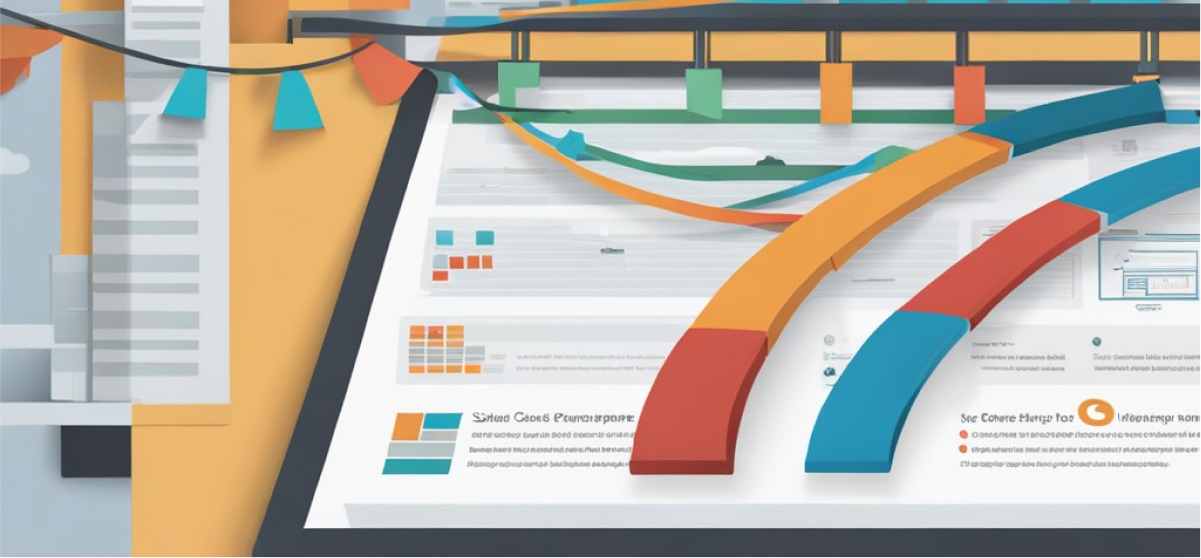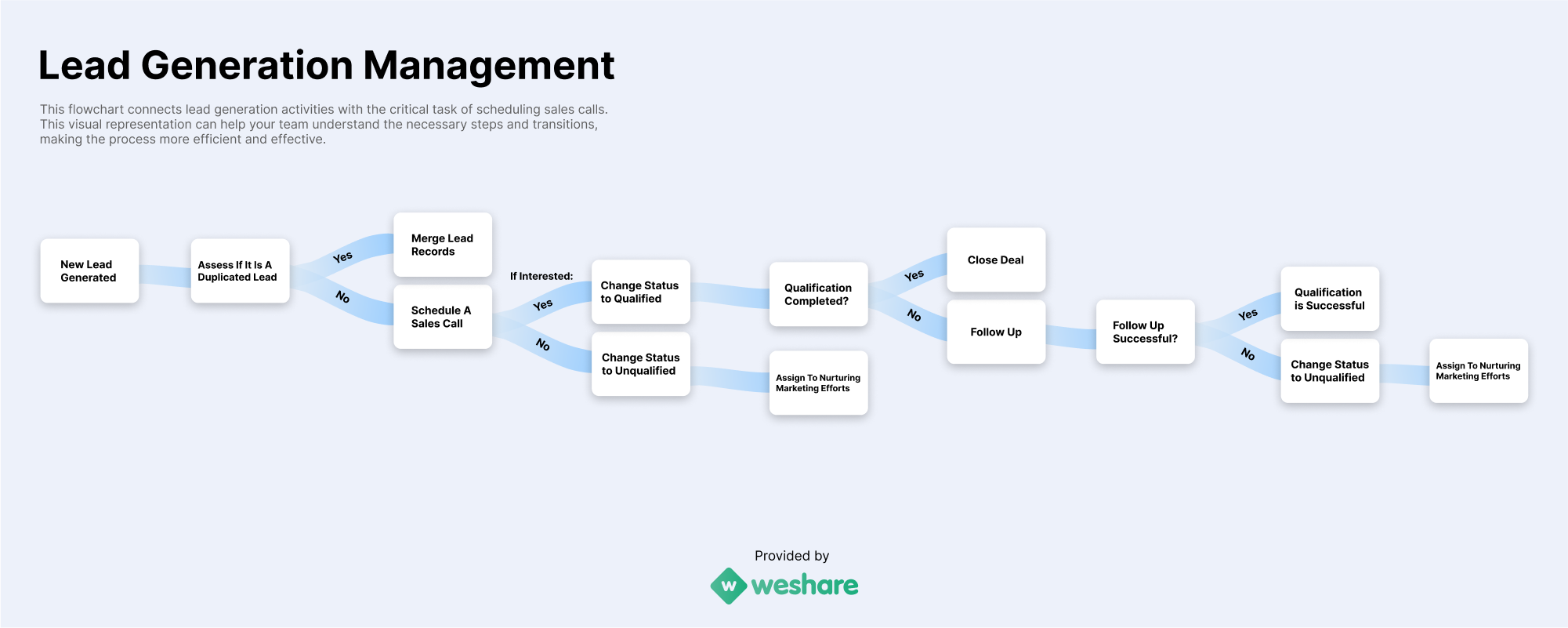Provided by Weshare.net, your go-to resource for the best tips and information about sales.
In the competitive world of sales, effectively managing the connection between lead generation and scheduling calls is crucial. This flowchart template is designed to help you visualize and streamline the process, ensuring a smooth transition of leads through your sales pipeline.
Understanding the Flowchart
Lead generation and scheduling sales calls are vital components of a successful business strategy. A well-structured flowchart can significantly improve your team’s efficiency and effectiveness in these areas. Below is a detailed guide, complete with a checklist and specific instructions, to help you navigate this process more effectively.
Lead Generation Phase
Identifying Potential Leads
- Use various strategies to gather potential leads, such as:
- Online marketing
- Social media campaigns
- Networking events
- Referral programs
Tip: Focus on platforms where your target audience is most active to increase lead relevance.
Gathering Lead Information
- Collect essential details such as:
- Contact information (name, email, phone number)
- Interest level
- Specific needs or preferences
Tip: Utilize CRM tools for efficient data collection and management.
Qualifying Leads
- Assess the leads based on predefined criteria like:
- Budget
- Authority
- Need
- Timeframe
Tip: Implement a scoring system to prioritize leads with higher conversion potential.
Scheduling Connection Phase
Initial Contact
- Reach out to the qualified leads via:
- Personalized email
- Direct phone call
Script Example for Email:
Subject: Let’s Explore New Opportunities Together
Hi [Name],
I came across your profile and noticed your interest in [specific interest]. At [Your Company], we specialize in [relevant service/product].
I believe we could greatly assist you in [specific benefit].
Would you be available for a quick call next week to discuss this further?
Best regards,
[Your Name]
Scheduling the Call
- Propose a time for a detailed discussion.
- Use tools like Calendly for easy scheduling.
- Offer multiple time slots for convenience.
Tip: Be flexible and consider different time zones if applicable.
Confirmation and Reminder
- Send a confirmation email with details like:
- Date and time of the call
- Agenda or topics to be discussed
- Contact information for any last-minute changes
Script Example for Confirmation:
Subject: Your Scheduled Call with [Your Company]
Hi [Name],
Thank you for scheduling a call with us. We are looking forward to discussing [agenda topics] on [date and time]. If you have any questions or need to reschedule, feel free to contact me at [your contact information].
Best regards,
[Your Name]
- Send a reminder a day before the appointment.
Checklist for Implementing the Flowchart
- Identify target audience and appropriate lead generation channels.
- Set up a system for collecting and managing lead information.
- Define criteria for lead qualification.
- Draft personalized scripts for initial contact and follow-ups.
- Choose a scheduling tool and set available time slots.
- Implement a system for sending confirmations and reminders.
By following this structured approach and utilizing the provided tips and scripts, you can streamline your lead generation and sales call scheduling processes, leading to more successful engagements and potential conversions.
Templates and Scripts Examples
Lead management is a critical aspect of sales and marketing strategies. This guide provides a comprehensive approach to managing leads, from initial contact to scheduling calls. With practical templates and scripts, you can streamline your process and increase your conversion rates.
Checklist for Effective Lead Management
- Identify and segment your leads.
- Personalize communication.
- Utilize a CRM system for tracking.
- Follow up promptly.
- Schedule calls or meetings.
- Maintain consistent communication.
- Evaluate and refine your lead management process.
Initial Contact Email Template
Subject: Unlocking Potential Opportunities with [Your Company]
Hi [Lead Name],
I’m [Your Name] from [Your Company].
Your work in [Lead’s Industry/Field] caught our attention. We believe our [product/service] aligns perfectly with your goals, especially regarding [specific aspect related to lead’s business].
Could we have a brief chat this week to explore this further?
Looking forward to connecting.
Warm regards,
[Your Name]
Tips for Initial Contact:
- Personalize the subject line and content based on the lead’s industry or recent achievements.
- Mention a specific aspect of their business that relates to your product or service.
- Keep it concise yet engaging.
Call Scheduling Script
“Hi [Lead Name], this is [Your Name] from [Your Company].
I enjoyed reading about your recent [project/achievement].
I believe our [product/service] can add significant value here.
Could we schedule a brief call to discuss this?
How does [date and time] sound to you?”
Tips for Scheduling Calls:
- Reference a recent accomplishment or news about the lead to show genuine interest.
- Propose a specific date and time to make scheduling easier.
- Be flexible and ready to offer alternative slots.
Confirmation Email Template
Subject: Your Scheduled Appointment with [Your Company] – [Date]
Hi [Lead Name],
Just touching base to confirm our call on [date and time].
I’m eager to discuss how [Your Company] can help with [specific aspect related to lead’s business].
See you soon!
Best,
[Your Name]
Tips for Confirmation Email:
- Reiterate the date and time clearly.
- Briefly mention the agenda or key discussion point.
- Ensure the tone is professional yet friendly.
Conclusion
Efficient lead management is essential for any sales-driven organization. By using these templates and scripts, along with a structured approach, you can enhance your lead engagement and conversion process. Remember to personalize your interactions and be responsive to the needs and timelines of your leads.
Remember, every interaction is an opportunity to build a relationship and trust, which are the cornerstones of successful sales.
Weshare’s Team – We’re in love with words, videos and everything in between. Our passion for helping people manage a business is evident in every article. We’re happy to be there in every part of the way – from starting to growing a successful business.
We Also Reviewed
- 45+ Advertising Statistics That Will Blow Your Mind
- 33 CRM Statistics You Should Know
- 41+ Public Speaking Statistics You Should Know
- 35 Machine Learning Statistics You Should Know
- 34 Employee Burnout Statistics You Should Know
- 39+ Communication Statistics You Need To Know
- 37+ Cold Calling Statistics You Need To Know
- 21+ Entrepreneur Statistics You Should Know
- 35+ Contract Management Statistics You Should Know
- 37+ Zoom Statistics You Should Know
- 35+ Sales Training Statistics You Should Know About
- 75+ WordPress Statistics You Need to Know
- 41+ Startup Statistics You Need to Know
- 37+ Presentation Statistics You Need To Know
- 41+ Recruiting Statistics You Need to Know
- 23+ Apple Podcast Statistics You Should Know About
- 31+ Spotify Podcast Statistics You Should Know About
- 35+ Spotify Statistics You Should Know

